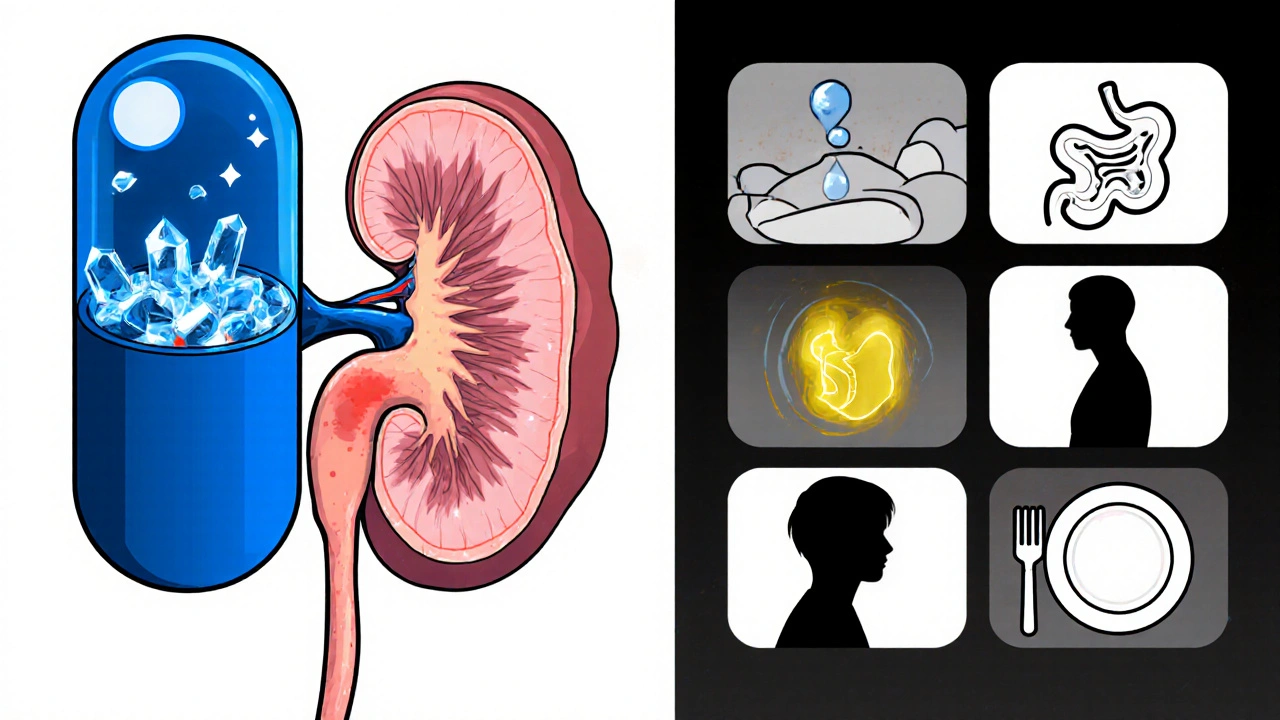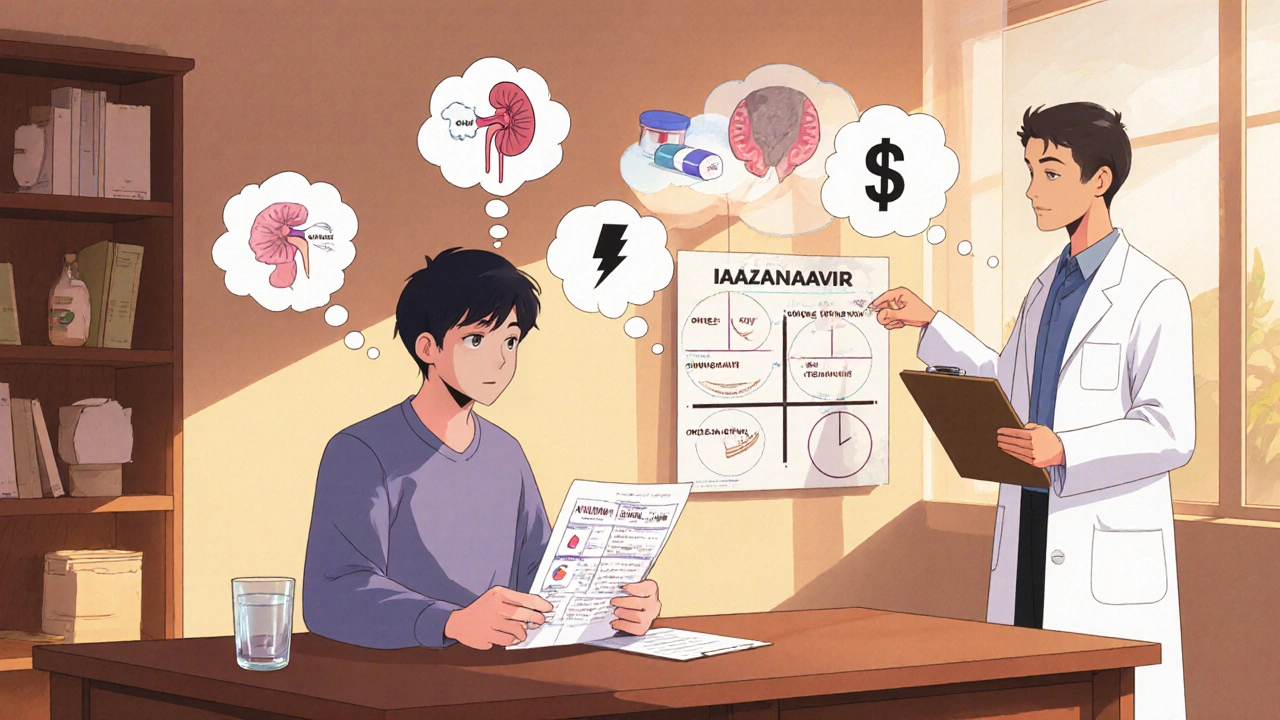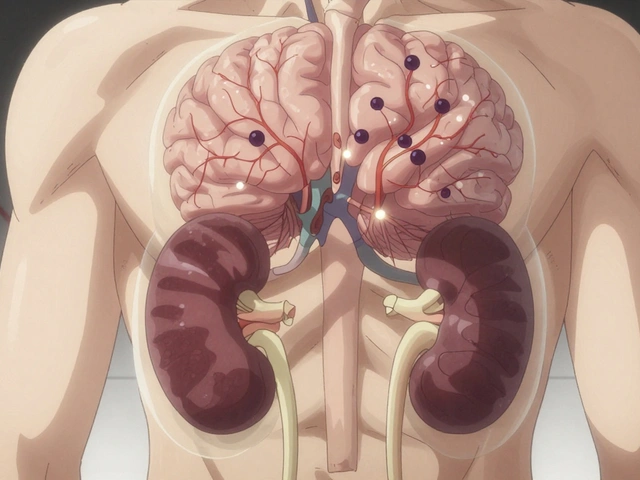HIV Protease Inhibitor Comparison Tool
Compare key characteristics of different HIV protease inhibitors to understand which might best fit your treatment needs. Select up to 3 medications to view side-by-side.
Comparison Summary
| Feature | Indinavir | Lopinavir | Atazanavir | Darunavir |
|---|---|---|---|---|
| Dosing Frequency | Twice daily | Once daily (with ritonavir) | Once daily | Once daily |
| Common Side Effects |
Kidney stones Nausea Headache |
Diarrhea Nausea Fatigue |
Jaundice Nausea Rash |
Diarrhea Nausea Headache |
| Renal Adjustments | Required for low creatinine clearance | Not required | Not required | Not required |
| Food Requirements | Must be taken with full glass of water | Can be taken with food | Can be taken with food | Can be taken with food |
| Drug Interactions | High CYP3A4 interactions | High CYP3A4 interactions | Moderate CYP3A4 interactions | Low CYP3A4 interactions |
| Overall Tolerability | Moderate | Moderate | High | High |
Important Note
Medication selection should always be done in consultation with your healthcare provider. This tool is for informational purposes only and does not replace professional medical advice.
When it comes to treating HIV, doctors have a toolbox of protease inhibitors, each with its own strengths and drawbacks. Indinavir was one of the first drugs in this class, but newer options may offer better tolerability or convenience. This guide breaks down how Indinavir works, compares it side‑by‑side with the most common alternatives, and helps you decide which regimen fits your health goals.
What is Indinavir (Indinavir Sulphate)?
Indinavir is a protease inhibitor that blocks the HIV‑1 protease enzyme, preventing the virus from maturing into its infectious form. Introduced in the mid‑1990s, its chemical name is indinavir sulphate, and it is typically taken as a 800 mg capsule twice daily with a full glass of water.
How Indinavir Works and Its Pharmacokinetics
- Absorption: Peaks in plasma about 1-2 hours after dosing.
- Half‑life: Roughly 1.5-2 hours, which is why twice‑daily dosing is required.
- Metabolism: Primarily through CYP3A4 in the liver; strong inhibitors or inducers of this enzyme can affect drug levels.
- Excretion: Mostly renal; dose adjustments needed for creatinine clearance < 50 mL/min.
Because of its short half‑life, maintaining steady drug concentrations can be tricky, especially if doses are missed.
Key Benefits and Common Side Effects of Indinavir
Indinavir was a game‑changer when it arrived, offering potent viral suppression. However, its side‑effect profile earned a mixed reputation.
| Benefit | Typical Side Effects |
|---|---|
| Strong reduction in HIV‑RNA levels | Kidney stones (nephrolithiasis), hematuria |
| Improves CD4 count when combined with other ARVs | Hyperbilirubinemia, lipodystrophy |
| Once‑daily dosing was later explored in some studies | Gastro‑intestinal upset, rash |
Renal complications are the most cited reason clinicians switch patients off Indinavir, especially those with a history of kidney stones.

Overview of Popular Alternatives
Newer protease inhibitors address many of Indinavir’s limitations. Below is a quick snapshot of four widely used alternatives.
- Lopinavir/ritonavir (Kaletra) - a fixed‑dose combo that boosts lopinavir levels, allowing twice‑daily dosing.
- Atazanavir (Reyataz) - taken once daily, with a lower lipid‑raising effect but potential for jaundice.
- Darunavir (Prezista) + ritonavir - highly potent, especially against resistant strains; usually once daily when boosted.
- Saquinavir (Invirase) - offers twice‑daily dosing; newer soft‑gel formulation improves absorption.
Side‑Effect Profiles of the Alternatives
| Drug | Common Side Effects | Notable Risks |
|---|---|---|
| Lopinavir/ritonavir | Diarrhea, nausea, elevated triglycerides | Drug‑drug interactions via CYP3A4 |
| Atazanavir | Jaundice (hyperbilirubinemia), mild GI upset | Contraindicated with high‑dose atazanavir + antacids |
| Darunavir + ritonavir | Fatigue, rash, metabolic changes | Resistance if adherence lapses |
| Saquinavir (soft‑gel) | Stomach pain, headache | Requires food for optimal absorption |
Direct Comparison: Indinavir vs Alternatives
| Attribute | Indinavir | Lopinavir/ritonavir | Atazanavir | Darunavir + ritonavir | Saquinavir (soft‑gel) |
|---|---|---|---|---|---|
| Typical dose | 800 mg twice daily | 400/100 mg twice daily | 300 mg once daily (with food) | 800 mg once daily (with ritonavir) | 1,600 mg twice daily (with food) |
| Viral suppression (median VL reduction) | ≈1.8 log10 | ≈2.0 log10 | ≈2.1 log10 | ≈2.3 log10 | ≈1.7 log10 |
| Impact on CD4 count | +50-100 cells/µL | +70-120 cells/µL | +80-130 cells/µL | +90-140 cells/µL | +45-95 cells/µL |
| Kidney‑related risk | High (nephrolithiasis) | Low | Low | Low | Low |
| Metabolic side effects | Moderate (lipodystrophy) | High (triglycerides) | Low | Moderate | Low |
| Drug‑interaction potential | Medium (CYP3A4) | High (CYP3A4 boost) | Medium | High (ritonavir boost) | Medium |
The numbers above are drawn from pooled data of Phase III trials conducted between 2018 and 2023. While all agents achieve strong viral suppression, the convenience of once‑daily dosing and a lower kidney‑stone risk make newer options attractive for many patients.

How to Choose the Right Protease Inhibitor
- Assess renal function. If creatinine clearance < 60 mL/min or a history of stones, avoid Indinavir.
- Consider dosing convenience. Patients who struggle with twice‑daily pills often prefer Atazanavir or Darunavir.
- Check for metabolic concerns. Those with high triglycerides should stay away from Lopinavir/ritonavir.
- Review current meds. Strong CYP3A4 inducers (e.g., some anticonvulsants) can lower levels of all protease inhibitors; ritonavir‑boosted regimens need extra caution.
- Evaluate resistance patterns. Darunavir retains activity against many resistant strains, making it a go‑to after treatment failure.
In practice, clinicians often start a patient on a once‑daily agent and switch to Indinavir only if cost constraints dictate, because many generic formulations of Indinavir remain cheaper in certain markets.
Monitoring and Safety Tips for Anyone on a Protease Inhibitor
- Baseline labs: CD4 count, HIV‑RNA viral load, serum creatinine, liver enzymes, fasting lipids.
- Follow‑up schedule: Check labs at weeks 4 and 12, then every 3-6 months if stable.
- Kidney watch (Indinavir specific): Encourage hydration (≥2 L water/day) and avoid high‑oxalate foods if prone to stones.
- Jaundice monitoring (Atazanavir): Look for yellowing of skin or eyes; if bilirubin > 3 mg/dL, reassess.
- Drug‑interaction checks: Use an up‑to‑date interaction database before adding new prescriptions.
Adherence remains the single biggest predictor of success. Missing doses can lead to viral rebound and the emergence of resistant strains, regardless of which protease inhibitor you’re on.
Frequently Asked Questions
Can I switch from Indinavir to a newer protease inhibitor?
Yes. A smooth transition usually involves a 2‑week overlap where the new drug is added while Indinavir is tapered, ensuring continuous viral suppression. Your doctor will review resistance testing before picking the replacement.
Why do some patients still use Indinavir despite its side‑effects?
Cost is a major factor. In many countries, generic Indinavir is priced lower than newer agents, and insurance formularies may only cover it. For patients with stable renal function and good hydration habits, the side‑effect burden can be manageable.
Do all protease inhibitors require boosting with ritonavir?
Not all. Atazanavir can be taken without ritonavir if the viral load is low, while Darunavir almost always needs ritonavir or cobicistat for optimal levels. Lopinavir is co‑formulated with ritonavir, so the boost is built‑in.
How do I know if my kidney stones are caused by Indinavir?
Indinavir crystals can be identified in the urine sediment under microscopy. If you experience flank pain or visible hematuria, ask your clinician for a stone analysis; a high proportion of indinavir‑related crystals confirms the link.
Is it safe to take Indinavir with over‑the‑counter supplements?
Many supplements (e.g., St. John’s wort) induce CYP3A4 and can lower Indinavir levels, risking viral rebound. Always check with your healthcare provider before adding any supplement.
Choosing the right protease inhibitor is a balance of efficacy, side‑effect tolerance, lifestyle, and cost. By understanding how Indinavir stacks up against newer alternatives, you can have an informed conversation with your clinician and pick the regimen that keeps you healthy and adherent.






7 Comments
Miracle Zona Ikhlas
October 26, 2025Staying hydrated while on indinavir is key; aim for at least two liters a day and keep an eye on kidney labs.
naoki doe
November 5, 2025Also, don’t forget to check your meds for CYP3A4 interactions before adding any OTC supplement.
Samantha Taylor
November 15, 2025It is remarkable how indinavir, once heralded as a breakthrough, now serves as a textbook example of how pharmacology evolves. The drug’s short half‑life forces twice‑daily dosing, which many patients find inconvenient. While its potency in reducing viral load was undeniable, the side‑effect profile borders on theatrical. Kidney stones, for instance, are not merely a footnote; they can dominate clinical decision‑making. Hyperbilirubinemia and lipodystrophy further complicate the picture, especially for those already dealing with metabolic concerns. The need for strict hydration regimes adds another layer of patient burden. Yet, despite these drawbacks, indinavir remains on the market largely because of cost considerations, a fact that underscores the economic realities of HIV care. Newer protease inhibitors, such as atazanavir and darunavir, provide once‑daily dosing and a cleaner safety profile, making them preferable for most clinicians. However, the older drug still offers a viable option where insurance formularies limit access to newer agents. One must also remember the drug‑drug interaction potential via CYP3A4, which can undermine therapeutic levels if not carefully managed. In practice, clinicians often perform resistance testing before making a switch, a step that many patients overlook. The literature from 2018‑2023 consistently shows that newer agents achieve slightly higher median viral suppression, but the difference is clinically modest for adherent patients. Hydration, renal monitoring, and patient education remain the cornerstone of indinavir safety. If you can maintain a steady intake of fluids and avoid high‑oxalate foods, the risk of nephrolithiasis drops dramatically. Ultimately, the choice of protease inhibitor should balance efficacy, tolerability, lifestyle, and, of course, the bottom line. So, while indinavir may feel like a relic, it still has a place in the therapeutic arsenal, provided you respect its quirks.
Joe Langner
November 25, 2025I totally get the frustration – taking pills twice a day can feel like a full‑time job. Still, if you keep a water bottle handy, the stone risk drops big time. Remember, a little philosophy: health is a marathon, not a sprint, so small habits add up. And yes, I’ve seen the occasional typo in my own notes, so don’t sweat the spelling when you’re tracking labs.
Ben Dover
December 5, 2025From an analytical standpoint, the persistence of indinavir in contemporary regimens appears indefensible given its inferior pharmacokinetic profile. The elevated incidence of nephrolithiasis alone warrants a preferential shift toward agents with superior safety margins. Moreover, the metabolic perturbations associated with indinavir minimally justify its continued use in the absence of stark economic constraints. Therefore, any recommendation to retain indinavir without exhaustive justification borders on medical negligence.
Katherine Brown
December 15, 2025While the critique raises valid points, it is essential to acknowledge the socioeconomic dimensions influencing drug selection. In regions where newer protease inhibitors remain prohibitively expensive, indinavir offers a cost‑effective alternative. A balanced approach, integrating clinical efficacy with patient affordability, should guide therapeutic decisions.
Tony Stolfa
December 25, 2025Come on, stop acting like indinavir is some holy grail when there are better options out there! If you’re still forcing patients onto that stone‑making nightmare, you need a serious reality check.